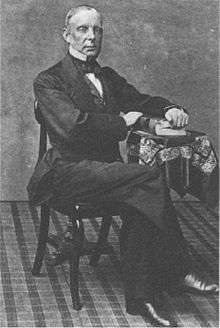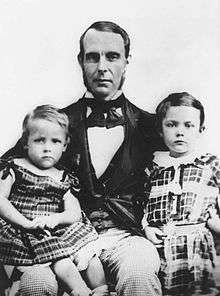George Morison Robertson
George Morison Robertson (February 26, 1821 – March 12, 1867) was an early politician and judge in the Kingdom of Hawaii. Born in Scotland, he settled in Hawaii in 1844 during the whaling era. During his career in Hawaii, he served in many political and judicial posts including circuit judge and police court judge, member of the Board of Commissioners to Quiet Land Titles, a multiple-term representative in the Hawaiian legislature, Speaker of the House of Representatives, Associate Justice of the Supreme Court of Hawaii and Minister of the Interior.
George Morison Robertson | |
|---|---|
 | |
| Speaker of the House of Representatives | |
| In office 1852–1853 | |
| Preceded by | William Little Lee |
| Succeeded by | Asa G. Thurston |
| In office 1855 – January 3, 1859 | |
| Preceded by | Asa G. Thurston |
| Succeeded by | James W. Austin |
| Associate Justice of the Supreme Court of Hawaii | |
| In office January 10, 1855 – December 24, 1863 | |
| Appointed by | Kamehameha III |
| In office February 16, 1864 – March 12, 1867 | |
| Appointed by | Kamehameha V |
| Minister of the Interior | |
| In office December 24, 1863 – February 16, 1864 | |
| Monarch | Kamehameha V |
| Preceded by | Lot Kapuāiwa (Kamehameha V) |
| Succeeded by | Charles Gordon Hopkins |
| Personal details | |
| Born | February 26, 1821 Huntly, Aberdeenshire, Scotland |
| Died | March 12, 1867 (aged 46) Waianae, Oahu, Kingdom of Hawaii |
| Nationality | Kingdom of Hawaii |
| Spouse(s) | Sarah Symonds Humphreys |
| Children | 7 |
Life and career
George Morison Robertson was born on February 26, 1821, at Huntly, Aberdeenshire, Scotland. His parents were John Robertson and Anne Morison. At the age of fifteen, he settled in Saint John, New Brunswick, Canada with his older brother.[1][2][3]
Robertson arrived in Hawaii in 1844 aboard the British whaling ship Peruvian. He was discharged and settled in Honolulu where he worked as a clerk in the firm of Skinner & Company. There he caught the attention of Robert Crichton Wyllie, a Scottish expatriate and Minister of Foreign Affairs, who recommended him to the Hawaiian government where he worked as Wyllie's assistant in the foreign ministry and later as a cashier and bookkeeper in the treasury department under Finance Minister Gerrit P. Judd.[3] In July 1848, he briefly served as interim or acting Minister of the Interior in the absence of Interior Minister Keoni Ana.[4]
In 1849, he took part briefly in the California Gold Rush but returned without much success after a year. He settled permanently in Hawaii and accepted an appointment as a member of the Board of Commissioners to Quiet Land Titles, succeeding Samuel Kamakau. The body was a government committee in charge of settling or quieting land claims of the Great Māhele. During his tenure from 1850 to 1855, he was responsible for the awarding of many of the present land titles in Hawaii and the distribution of kuleana lands to the commoners.[1][5][6] At the same time, he also served as police court judge for Honolulu and circuit court judge of the island of Hawaii.[1][4]
Robertson was also elected as a member of the House of Representatives in the Legislature of the Kingdom of Hawaii from 1851 to 1859.[4] The legislative election of 1851 was the first in Hawaii in which direct suffrage was introduced. Robertson and another naturalized foreigner, Thomas Charles Byde Rooke, were able to defeat the Native Hawaiian candidates for the representative seats in the district of Kona in Honolulu, despite the fact that a majority of the ballots cast were by Hawaiians.[7][8][9][10] He served as the Speaker of the House of Representatives from 1852 to 1859.[11]
Robertson was appointed to the Supreme Court of Hawaii in 1855 to succeed Lorrin Andrews. He served as the inaugural Associate Justice of the Supreme Court of Hawaii from January 1, 1855, to December 24, 1863. He left his justice seat briefly to serve in the cabinet of King Kamehameha V as his Minister of the Interior from December 24, 1863, to February 16, 1864. However, unable to find a suitable replacement for his justice seat, the king reappointed him to the Supreme Court from February 16, 1864, to his death on March 12, 1867.[4][12]
On April 11, 1865, King Kamehameha V made him a Knight Commander of the Royal Order of Kamehameha I.[4]
Personal life

In 1851, George Morison Robertson married Sarah Symonds Humphreys (January 19, 1824 – September 23, 1919), an Englishwoman from Brighton who was shipwrecked with her family at Waikiki while they were traveling to the California Gold Rush from Australia.[1][13][14][15] They had seven children including three sons and four daughters:[1][16]
- James William Robertson (December 12, 1852 – January 28, 1919), who served as a royal court official and chamberlain to King Kalākaua and Queen Liliuokalani. He married Rose Kaipuala Cleghorn (1859–1911), the daughter of Archibald Scott Cleghorn and half-sister of Princess Kaʻiulani, and had seven children.[17][18]
- George Humphreys Robertson (October 19, 1854 – April 29, 1919), who became a Honolulu businessman and later vice president of C. Brewer & Co. He married Caroline Hawea Boyd (1868–1913) and had five children.[19]
- Elizabeth Robertson (November 2, 1856 – September 11, 1940), who married German businessman Frederick Augustus Schaefer and had seven children.[20]
- Florence Robertson (March 25, 1859 – February 11, 1960), who married William R. Lawrence and lived to be a centenarian.[21][22]
- Margaret Ann Robertson (c. 1861 – August 8, 1862), who died young on the bark Comet.[23]
- Grace Gordon Robertson (January 23, 1866 – December 1, 1943) who was married.[1]
- Alexander G. M. Robertson (September 3, 1867 – August 21, 1947), who served as a politician of the Republic of Hawaii and Territory of Hawaii and later Chief Justice of the Hawaii Supreme Court from 1911 to 1918.[24][25][26][27] He married May 29, 1907 to Hawaiian opera singer Ululani McQuaid (1890–1970).[28]
Robertson was initially a Presbyterian, the religion he was brought up in, and worshiped at the Seamen's Bethel Church under Reverend Samuel C. Damon. He later joined the Anglican Church of Hawaii in 1862 at the request of King Kamehameha IV who wanted him as a supporter for the new Christian denomination. Robertson helped lay the cornerstone for the St. Andrew's Cathedral during the reign of Kamehameha V.[29][30]
Death
While on a vacation to Waianae with his eldest son James, Robertson stayed the night at the home of a Mr. Mahelona. He had been complaining of heart and rheumatic problems for the past few months. While reading a newspaper there, he fell unconscious and died of an aortic aneurysm, on March 12, 1867, at the age of forty-six.[29] His funeral service was conducted at St. Andrew's Cathedral and he was given a state funeral at the expense of the government. The king, the court, government and diplomatic officials, Honolulu residents and officers of the USS Lackawanna took part in the funeral procession. He was buried in the Oahu Cemetery.[1][30]
His obituary in The Pacific Commercial Advertiser noted: "Judge Robertson’s death will be a great loss to the community, but especially to the government, in which he was a wise counselor and an impartial, upright judge. Native Hawaiians always found in him a kind friend and adviser, and learned to trust to his wisdom. It will be impossible to fill the vacant judgeship with a man of the same varied qualifications, for there is no one living possessed of the knowledge of the native language combined with the firmness, impartiality and virtue which he had."[29]
Honours

References
- Nellist, George F., ed. (1925). "George Morison Robertson, Jurist and Statesman". The Story of Hawaii and Its Builders. Honolulu: Honolulu Star-Bulletin.
- Waldron 1967, pp. 1–5.
- Van Dyke 2008, pp. 79–80.
- "Robertson, George Morrison [sic] office record" (PDF). state archives digital collections. state of Hawaii. Retrieved May 11, 2017.
- Van Dyke 2008, pp. 35, 49.
- Moffat & Fitzpatrick 1995, p. 43.
- Osorio 2002, pp. 67–73.
- Spaulding 1930, pp. 30–31.
- Van Dyke 2008, pp. 142–143.
- "Election For Members Of Parliament". The Polynesian. 7 (35). Honolulu. January 11, 1851. p. 2.
- Hawaii & Lydecker 1918, pp. 32, 35, 51, 55, 61, 64, 69, 74.
- Van Dyke 2008, p. 170.
- "Loss Of Am. Brig Fortunio". The Polynesian. 8 (2). Honolulu. May 24, 1851. p. 1. Archived from the original on August 13, 2018. Retrieved January 12, 2020.
- Waldron 1967, p. 5.
- "Mrs. Robertson Dies, Aged 96". The Pacific Commercial Advertiser. Honolulu. September 23, 1919. p. 6. Retrieved January 12, 2020.
- Gregg 1982, p. 524.
- "Robertson, James William office record" (PDF). state archives digital collections. State of Hawaii. Archived (PDF) from the original on January 9, 2019. Retrieved May 11, 2017.
- Siddall 1917, pp. 218, 225–227
- Waldron 1967, p. 10.
- Siddall 1917, p. 235; Siddall 1921, p. 351
- Episcopal Church in Hawaii (February 1960). "In Memoriam" (PDF). Hawaiian Church Chronicle. Vol. 50 no. 2. Honolulu: Episcopal Church in Hawaii. p. 8. hdl:10524/47758.
- Episcopal Church in Hawaii (April 1959). "Celebrates 100th Birthday" (PDF). Hawaiian Church Chronicle. Vol. 48 no. 4. Honolulu: Episcopal Church in Hawaii. p. 8. hdl:10524/47750.
- "Died". The Pacific Commercial Advertiser. Honolulu. October 2, 1862. p. 2.
- Van Dyke 2008, pp. 84, 244–245.
- "Robertson, Alexander George Morrison [sic] office record" (PDF). state archives digital collections. state of Hawaii. Archived (PDF) from the original on November 19, 2018. Retrieved May 11, 2017.
- Nellist, George F., ed. (1925). "Alexander G. M. Robertson, Jurist and Lawyer". The Story of Hawaii and Its Builders. Honolulu: Honolulu Star-Bulletin.
- Siddall 1917, p. 225; Siddall 1921, pp. 339–341
- Hall 1992, pp. 166–170.
- "Death of Hon. Geo. M. Robertson". The Pacific Commercial Advertiser. XI (37). Honolulu. March 16, 1867. p. 2.
- "Funeral of Judge Robertson". The Pacific Commercial Advertiser. XI (38). Honolulu. March 23, 1867. p. 3.
Bibliography
- Gregg, David L. (1982). King, Pauline (ed.). The Diaries of David Lawrence Gregg: An American Diplomat in Hawaii, 1853–1858. Honolulu: Hawaiian Historical Society. OCLC 8773139.CS1 maint: ref=harv (link)
- Hall, Dale E. (1992). "Two Hawaiian Careers in Grand Opera". The Hawaiian Journal of History. Honolulu: Hawaiian Historical Society. 26: 165–183. hdl:10524/618. OCLC 60626541.CS1 maint: ref=harv (link)
- Hawaii (1918). Lydecker, Robert Colfax (ed.). Roster Legislatures of Hawaii, 1841–1918. Honolulu: Hawaiian Gazette Company. OCLC 60737418.
- Moffat, Riley Moore; Fitzpatrick, Gary L. (1995). Surveying the Mahele: Mapping the Hawaiian Land Revolution. Honolulu: Editions Limited. ISBN 978-0-915013-17-3. OCLC 33045472.CS1 maint: ref=harv (link)
- Osorio, Jon Kamakawiwoʻole (2002). Dismembering Lāhui: A History of the Hawaiian Nation to 1887. Honolulu: University of Hawaii Press. ISBN 0-8248-2549-7. OCLC 48579247.CS1 maint: ref=harv (link)
- Siddall, John William (1917). Men of Hawaii. 1. Honolulu: Honolulu Star-Bulletin. OCLC 16326675.CS1 maint: ref=harv (link)
- Siddall, John William (1921). Men of Hawaii. 2. Honolulu: Honolulu Star-Bulletin. OCLC 16326675.CS1 maint: ref=harv (link)
- Spaulding, Thomas Marshall (1930). "Early Years of the Hawaiian Legislature". Thirty-Eighth Annual Report of the Hawaiian Historical Society for the Year 1929. Honolulu: Hawaiian Historical Society: 25–33. hdl:10524/33. OCLC 2105039.CS1 maint: ref=harv (link)
- Van Dyke, Jon M. (2008). Who Owns the Crown Lands of Hawaiʻi?. Honolulu: University of Hawaii Press. ISBN 978-0-8248-6560-3. OCLC 257449971 – via Project MUSE.CS1 maint: ref=harv (link)
- Waldron, Else (1967). Honolulu 100 Years Ago. Honolulu: Fisher Print Company. OCLC 433915.CS1 maint: ref=harv (link)
Further reading
- Cooke, Lydia (Pat) Schaefer (1973). The Family of George Morison Robertson and Sarah Symonds Humphreys Robertson After 122 Years, 1851–1973 (2nd ed.). Honolulu: Hawaiian Printing Co., Ltd. OCLC 10930635.